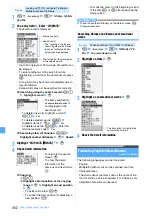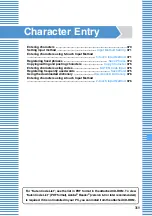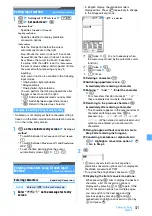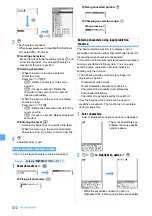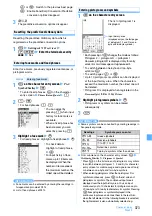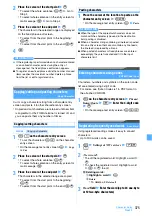
372
Character Entry
3
o
The characters are fixed.
・
When
Input prediction
of Input Method Setting is
ON
, select
閉じる
(Close).
■
Inserting characters:
Move the cursor to the insertion point by
O
and
enter the character. The entered character is
inserted at the cursor position.
■
Deleting characters:
・
When the cursor is inside an entered
character string
Example:
ドコモ
郎
・
c
: Delete a character at the cursor
position.
・
c
(for over a second): Delete the
character at the cursor position and all
following characters.
・
When the cursor is at the end of an entered
character string
Example:
ドコモ太郎
・
c
: Delete the character at the left of the
cursor position.
・
c
(for over a second): Delete all entered
characters.
■
Entering line feed:
#
・
Some entry fields may not permit a line feed.
・
When the cursor is in the end of an entered
character string,
d
allows to start a new line.
4
o
Character entry is quit.
・
Up to 24 two-byte characters can be converted.
1
Enter characters
z
p
■
Fixing all characters:
m
■
Fixing converted portion:
o
■
Changing conversion range:
&
Entering characters using input prediction
function
The input prediction function is to display a list of
predictive conversion options that match the first part of
the reading when characters are entered.
This function automatically registers previously entered
words as predictive dictionary data. You can easily
enter the same characters next time, quickly by
entering only the first part.
・
The following words and character strings are
displayed as options:
・
Standard recorded words
・
Words entered by kana/kanji conversion
・
Character string converted and entered by
Downloaded Dictionary
・
Character strings registered by Save Word
・
Only the hiragana/kanji mode can be used in
predictive conversion. The function is not available
during in-line entry.
1
Enter characters
A list of predictive conversion options is displayed.
2
d
z
O
to highlight an option
z
o
・
While the predictive conversion option is
highlighted, the following operations are enabled:
Block conversion of multiple clauses
Example
Entering “
動物園に行きましょう。
”
p
p
or
d
太
When pressing
l
・
The more characters are
entered, the more specific
options appear.
Summary of Contents for FOMA D905I
Page 1: ......
Page 446: ...444 MEMO...
Page 447: ...445 MEMO...
Page 448: ...446 MEMO...
Page 449: ...447 MEMO...
Page 450: ...448 MEMO...
Page 451: ...449 MEMO...
Page 452: ...450 MEMO...
Page 453: ...451 Index Quick Manual Index 452 Quick Manual 458...





